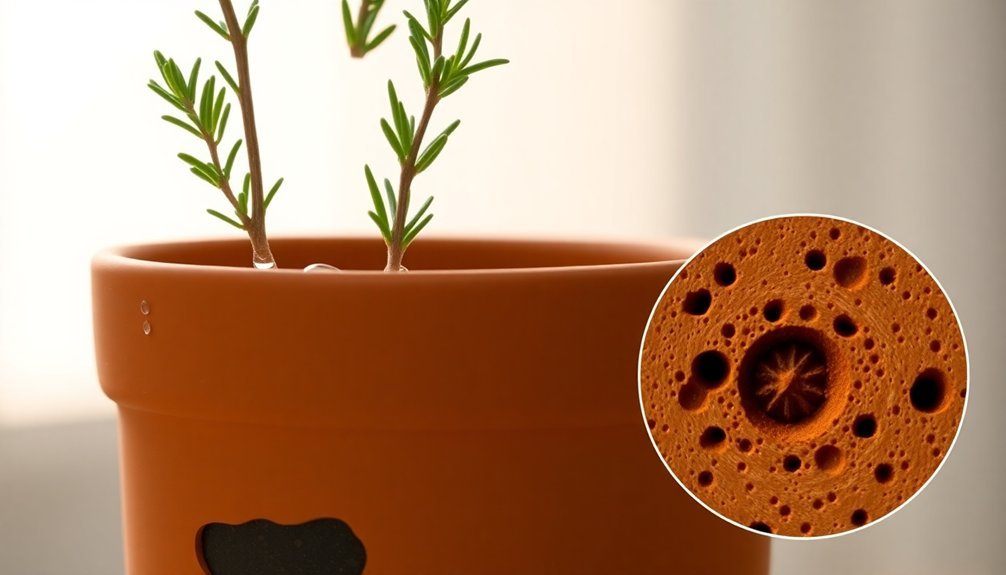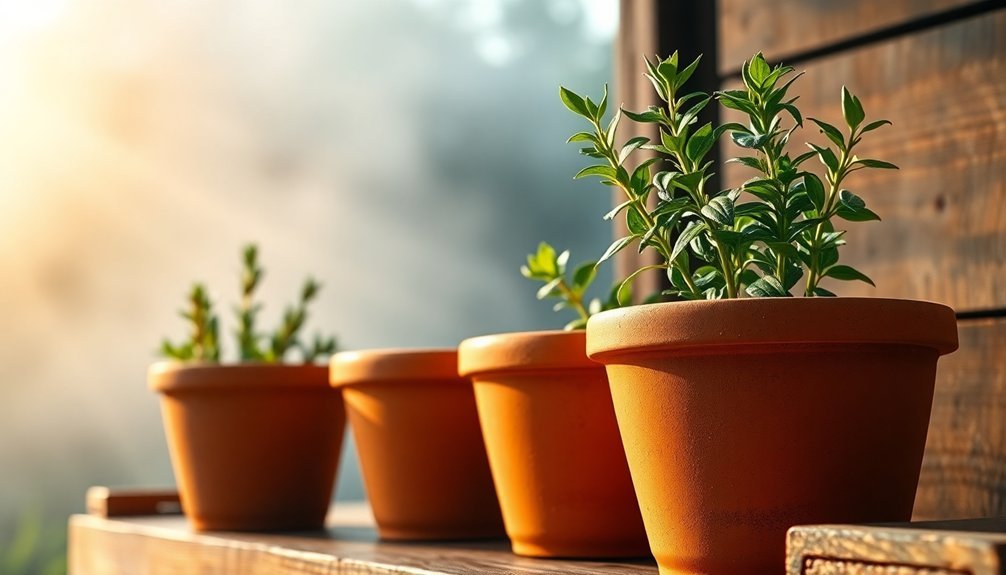Clay pots help keep your herbs fresher for longer thanks to their unique natural properties. You'll benefit from their porous structure that regulates moisture and prevents waterlogged roots, while the natural evaporative cooling protects delicate root systems. These pots maintain stable soil temperatures and enhance air circulation, creating an ideal environment for herb growth. When you combine them with well-draining potting soil and proper drainage holes, clay pots can extend herb freshness up to three weeks in prime conditions. With the right placement and care, you'll discover even more ways these versatile containers can enhance your herb garden's success.
Natural Temperature Control Benefits

When you're growing herbs in clay pots, you'll benefit from their remarkable natural temperature control system. Through evaporative cooling, these pots work similarly to human perspiration – as water evaporates from the clay surface, it naturally cools the soil and protects your herbs' delicate root systems. You'll notice the pots feel cooler to the touch, even on hot days, indicating this cooling process is actively working.
Clay's natural insulation properties help maintain stable soil temperatures year-round. In summer, your pots will shield roots from excessive heat, while in winter, they'll retain warmth to protect against cold. The porous nature of clay allows proper air circulation, which further enhances temperature regulation. Careful handling during seasonal transitions is essential since clay pots can crack. You'll find this especially beneficial for temperature-sensitive herbs.
To maximize these temperature control benefits, you can strategically place your clay pots. Position them in shaded, well-ventilated areas to enhance cooling effects, or use darker-colored pots to absorb more warmth in winter.
Consider placing heat-sensitive herbs on the north or east side of your pot arrangements, where they'll receive ideal temperature regulation throughout changing seasons.
Soil Moisture Balance
Beyond temperature control, clay pots offer a significant advantage in maintaining proper soil moisture balance for your herbs. The porous nature of clay allows excess moisture to evaporate through the pot's walls, preventing the waterlogged conditions that can lead to root rot. This is particularly beneficial for herbs like rosemary and thyme that prefer drier conditions.
You'll find that clay pots work exceptionally well with both sandy and loamy soils, as they help regulate moisture levels naturally. When you're growing moisture-loving herbs like mint or basil, the clay's ability to retain some moisture while preventing saturation creates an ideal environment. Light fertilization in early spring helps promote healthy growth while maintaining proper moisture balance.
The pot's material complements the finger test method – when you check the top inch of soil, you'll get a more accurate reading of your herbs' water needs.
For best results, combine your clay pots with well-draining potting soil mixed with organic matter and guarantee proper drainage holes. You'll need to water more frequently than with plastic containers, but this increased attention actually benefits your herbs by preventing overwatering and maintaining consistent moisture levels that match each herb's specific requirements.
Root Health Through Porosity

The dual nature of clay pot porosity presents both benefits and challenges for root health in your herb garden. While terra cotta pots excel at providing natural air circulation and water movement, they can also compete with your herbs for essential water and nutrients.
You'll find that these porous containers offer excellent protection against root rot through their ability to regulate moisture and provide drainage. Regular monitoring of water and soil chemistry is essential for preventing mineral accumulation. However, you should monitor your herbs closely, as the clay's absorption properties might lead to mineral buildup and affect root development.
Here's what you'll need to watch for in your clay-potted herbs:
- Roots wrapping around the pot's exterior, indicating water competition
- Yellowing or shriveling leaves, which may signal nutrient deficiency
- Fungus gnats or sour smells that suggest potential root rot
- Slow growth patterns that could mean the roots aren't getting enough resources
If you notice your herbs struggling, consider switching to glazed ceramic pots. These nonporous alternatives can promote healthier root systems by allowing roots to grow naturally into the potting mix rather than competing with the container walls for moisture and nutrients.
Fresh Herb Storage Duration
Proper root care in clay pots directly impacts how long you'll be able to store and enjoy your freshly harvested herbs. When you've cultivated healthy roots, you can expect your harvested herbs to maintain peak quality for up to three weeks when stored at 0°C (32°F), or two weeks at 5°C (41°F).
You'll need to adjust your storage approach based on the specific herbs you're growing. While most herbs thrive in cool conditions, basil and shiso require temperatures above 10°C (50°F) to prevent chilling damage.
To maximize storage life, you'll want to maintain humidity levels between 55-62% and avoid temperature fluctuations.
For your harvested herbs, you've got several storage options. You can use one-quart deli containers for long-stemmed varieties like parsley and cilantro, or opt for airtight containers with rubber gaskets.
Don't forget to change the water every other day if you're storing herbs upright in water. You can add lemon juice or a vitamin C tablet to prevent bacterial growth. Remember to trim the stems before storage and avoid overcrowding your containers.
Regular inspection for mold or decay will help guarantee your herbs stay fresh throughout their storage period.
Weather Impact On Clay Pots

Weather patterns greatly influence your clay pots' longevity and performance. When temperature drops, water trapped inside your pots can freeze and expand, causing cracks or complete breakage. This is especially true for terracotta pots, which are naturally porous and more susceptible to frost damage than ceramic or fiber clay alternatives.
To protect your herb pots from harsh weather conditions, you'll need to implement specific preventive measures:
- Elevate your pots using pot feet to prevent ground freezing and maintain proper drainage
- Remove saucers during winter months to avoid water accumulation that can lead to freezing damage
- Wrap your pots with insulating materials like burlap or bubble wrap when frost is expected
- Place pots in sheltered corners away from rain and drafts to minimize freeze-thaw cycles
If you're using terracotta pots, pay extra attention to drainage. Place broken crocks over drainage holes and regularly check for blockages.
For year-round herb growing, consider hand-thrown pots fired at high temperatures, as they're more frost-resistant. Remember, dry pots aren't affected by frost, so maintaining proper drainage is your best defense against weather-related damage.
Frequently Asked Questions
Can I Paint Clay Pots Without Affecting Their Beneficial Properties for Herbs?
You can paint the outside of clay pots, but don't paint the inside or rim. By keeping the pot's interior unpainted, you'll maintain its beneficial properties like moisture control and air circulation for herbs.
What Type of Saucer Material Works Best Under Clay Pots?
You'll want an unglazed clay saucer to match your pot's breathability. While it may need sealing to prevent leaks, it maintains the pot's natural moisture balance better than glazed or plastic alternatives.
How Do I Clean Old Clay Pots Before Reusing Them?
First, scrub off debris with steel wool and a wire brush. Then soak your pots in a 10% bleach solution for several hours. Finally, rinse thoroughly and dry completely before reuse.
Should Clay Pots Be Sealed on the Inside Before Planting Herbs?
You don't need to seal clay pots for herbs. Their natural porosity helps with root health and moisture balance. If you're concerned about water loss, try soaking the pot before planting instead.
Can Multiple Herb Varieties Be Planted Together in One Clay Pot?
Yes, you can plant multiple herbs together in a clay pot if they share similar growing requirements. Just make sure you've got good drainage and enough space for their roots to develop properly.
In Summary
You'll find clay pots are your best allies for keeping herbs fresh and thriving. They'll regulate temperature naturally, maintain ideal soil moisture, and let roots breathe through porous walls. Your herbs can last weeks longer when stored properly in clay containers. Just remember to protect them from extreme weather, and you'll enjoy fresh, healthy herbs whenever you need them for cooking or medicinal use.





Leave a Reply